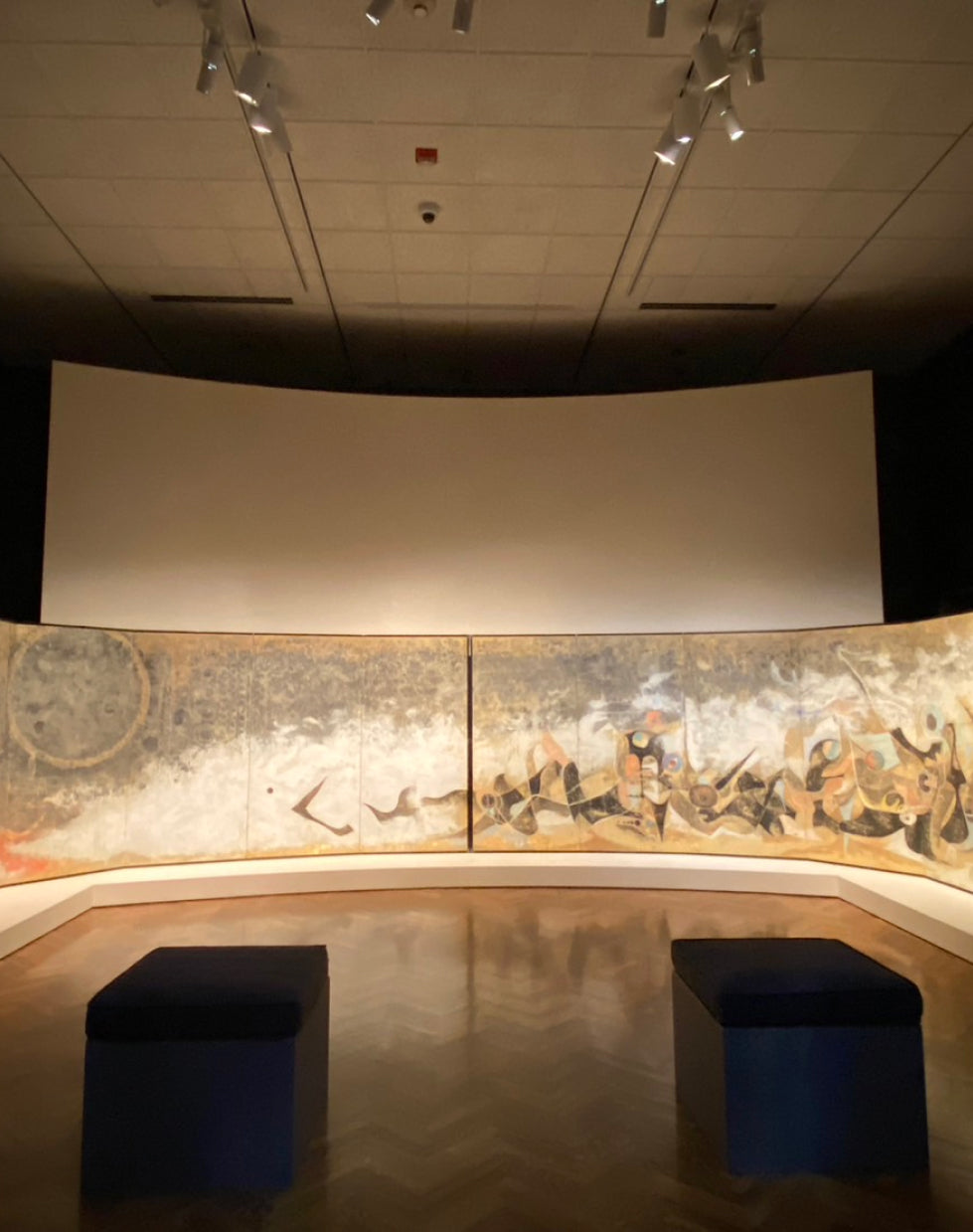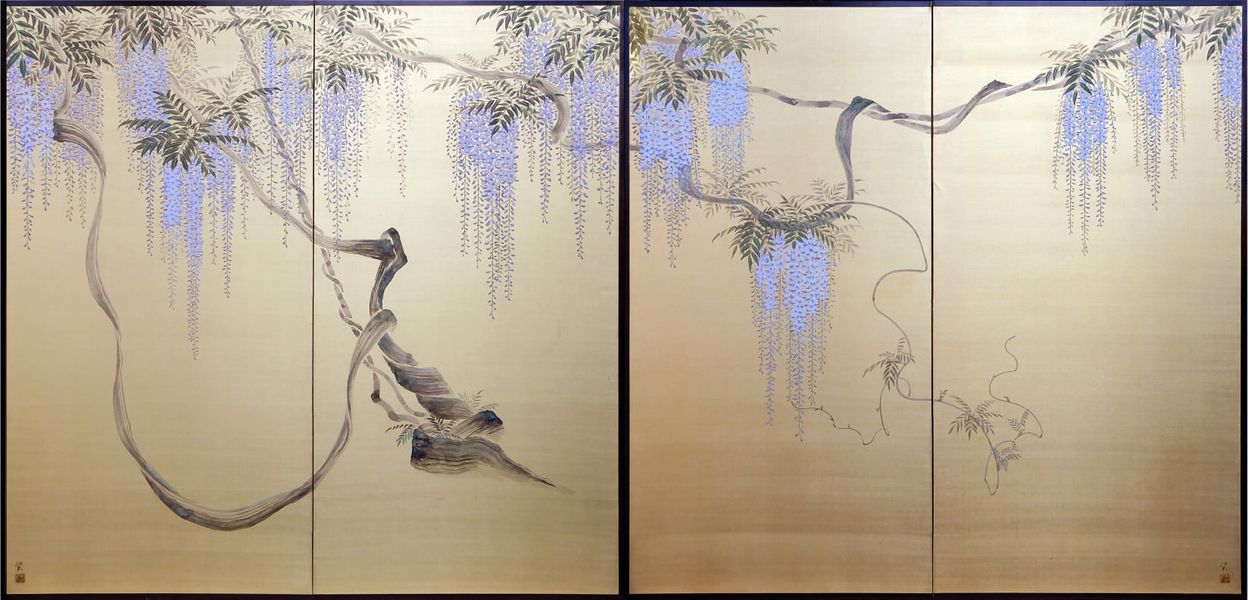
Matsubara Ken
Matsubara Ken Exhibition: Painting "Wisteria"
April 16th - April 25th, 2021
展览
Exhibition view
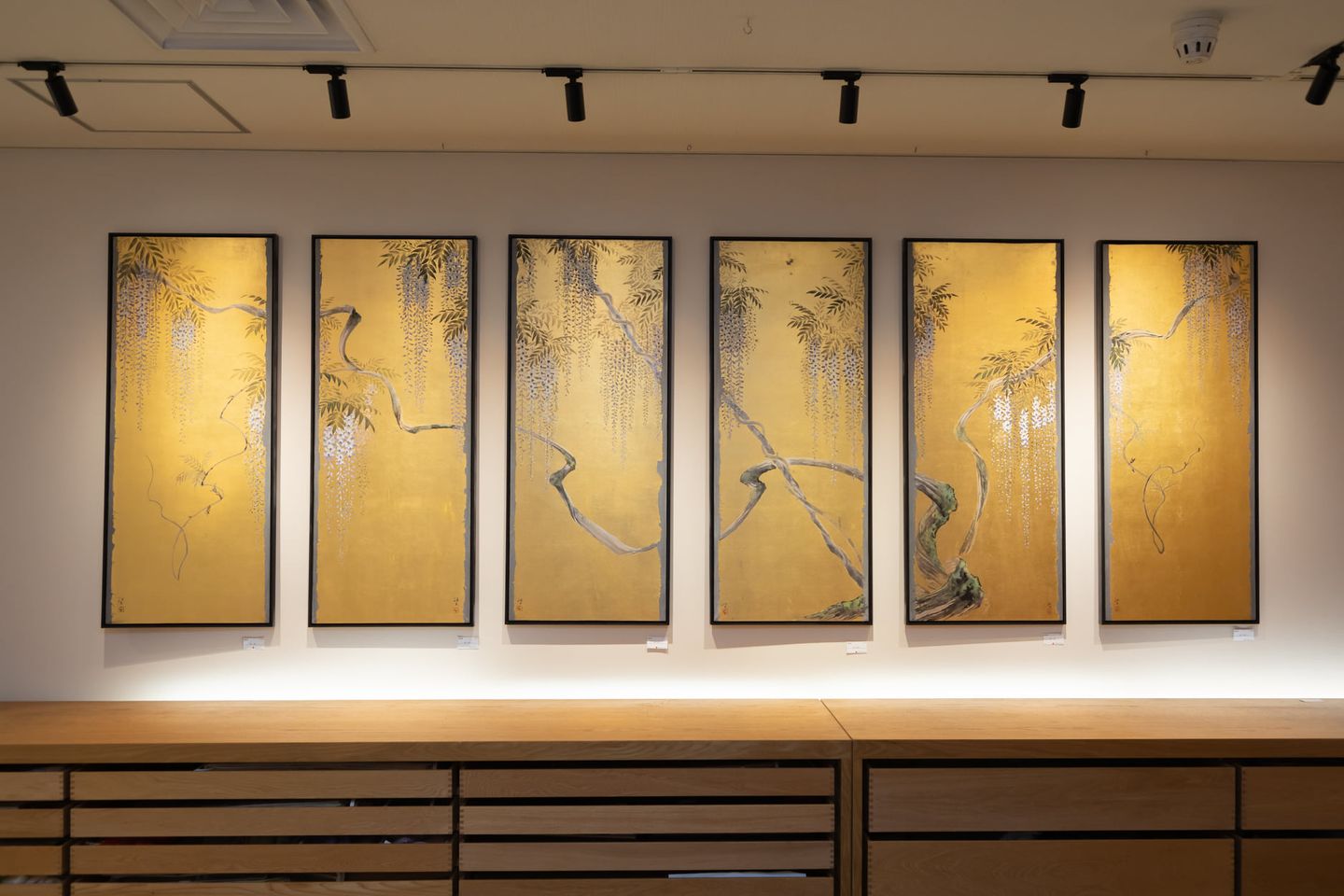
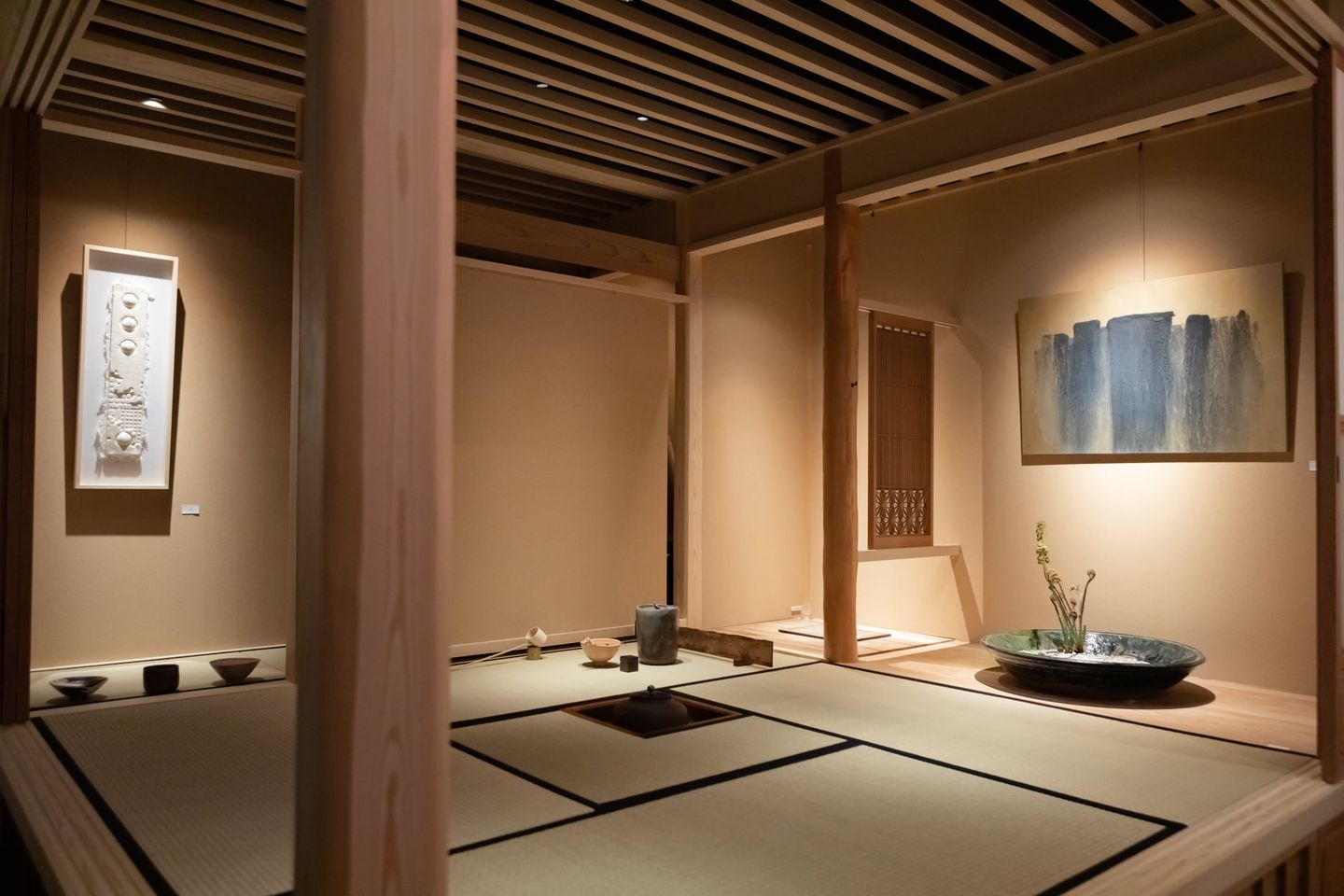

Drawing "Wisteria"
I have been creating works using sound as a motif for over 40 years, and it has been a long time since I last worked on what is commonly called "drawing."
Last year, I received a pair of antique two-panel gold folding screens from a mounter friend. The image of "Wisteria Flowers" that I had previously promised to paint with Aono-san of Ippodo came to mind. I remember being fascinated by Maruyama Okyo's Wisteria Flowers Screen that I saw at the Nezu Museum when I was young, and thinking, "I will do it too someday." However, that thought was buried deep in the drawer of time. Aono-san pulled the handle, a master of opening drawers.
Professor Seizo Hayashiya was also like that. When he was alive, he used to say, "Ken, Rinpa is like a drug."
When I asked him if it was really that dangerous, he replied, "No, it's just that it's so attractive." I agreed.
I went to a nearby wisteria trellis to do some research on wisteria, but it was different. I remember seeing lots of wisteria at Shoujinzawa when I visited before. I set out early in the morning. The flowers were already over, but vines the size of a man's arms were growing out of the edge of a mountain stream, where abundant spring water flows, and they were twisting and spiraling like a dragon climbing up into the sky. The trees that were wrapped around them had fallen and rotted under their weight, and the stumps at their base were covered in moss, nurturing new life. The energy and circulation of life was pristine and overflowing. In the morning mist, surrounded by the shapes of the tangled vines and the smell of moss, I spent a blissful time as if I had wandered into another dimension.
Ken Matsubara
This wisteria screen was painted by Matsubara Ken, not Okyo. The wisteria trunks and vines are drawn in one stroke, like calligraphy, on gold leaf. The flower clusters are as light as the light pouring down from the sky, swaying in the wind.
In his youth, Ken Matsubara admired Inoue Sanko and became his last disciple. He has been creating abstract mud paintings with the theme of "sound" without using a brush. In recent years, he has been creating the "Kuu Kai" series, including Moon Voice and Scenery.
The Kakiotoshi Kukai exhibition at the opening of the new Ippodo Gallery New York in 2019 was a spectacular sight, with 24 sliding door paintings of the sky, sea, sun and moon displayed across the entire gallery, creating an almost cosmic atmosphere.
He shyly showed me a photo of a cherry blossom and maple screen that he had painted at the request of Mr. Seizo Hayashiya three or four years ago. It was a painting done with a brush in the style of the Rinpa school. In the next moment, he said, "Please paint me a picture of wisteria too."
Wisteria is my favorite flower. The Fujimusume in Japanese dance, the Karaori wisteria in Noh costumes, and the wisteria flower clusters on the trellis are all so beautiful I am speechless. But Matsubara Ken's wisteria is different. It draws you into a mysterious world in the mist. It invites you to a mysterious world far, far away.
At the end of February, he took me to the Naojinzawa Forest in Nasu, where he found the wisteria trunks and vines. There, spring water overflows in layers, and wisteria grows in clusters around the trees around the river. The wisteria vines are spiraling around large trees, their owners gone. Wisteria trees resembling giant snakes or dragons grow here and there.
Matsubara Ken was looking at Maruyama Okyo's Wisteria Painting. He was looking for the trunk and vines, not the flower clusters, and when he found them in this forest, his eyes must have lit up like a boy's.
Thus, the exhibition "Matsubara Ken Paints Wisteria" was held at Ippodo.
What do you think Hayashiya Seizo in heaven would think when he sees the Cherry Blossom and Maple Screen and this Wisteria Screen?
I want to say, "Ahem!" And then, "Rinpa is like a drug."
Keiko Aono, Ippodo
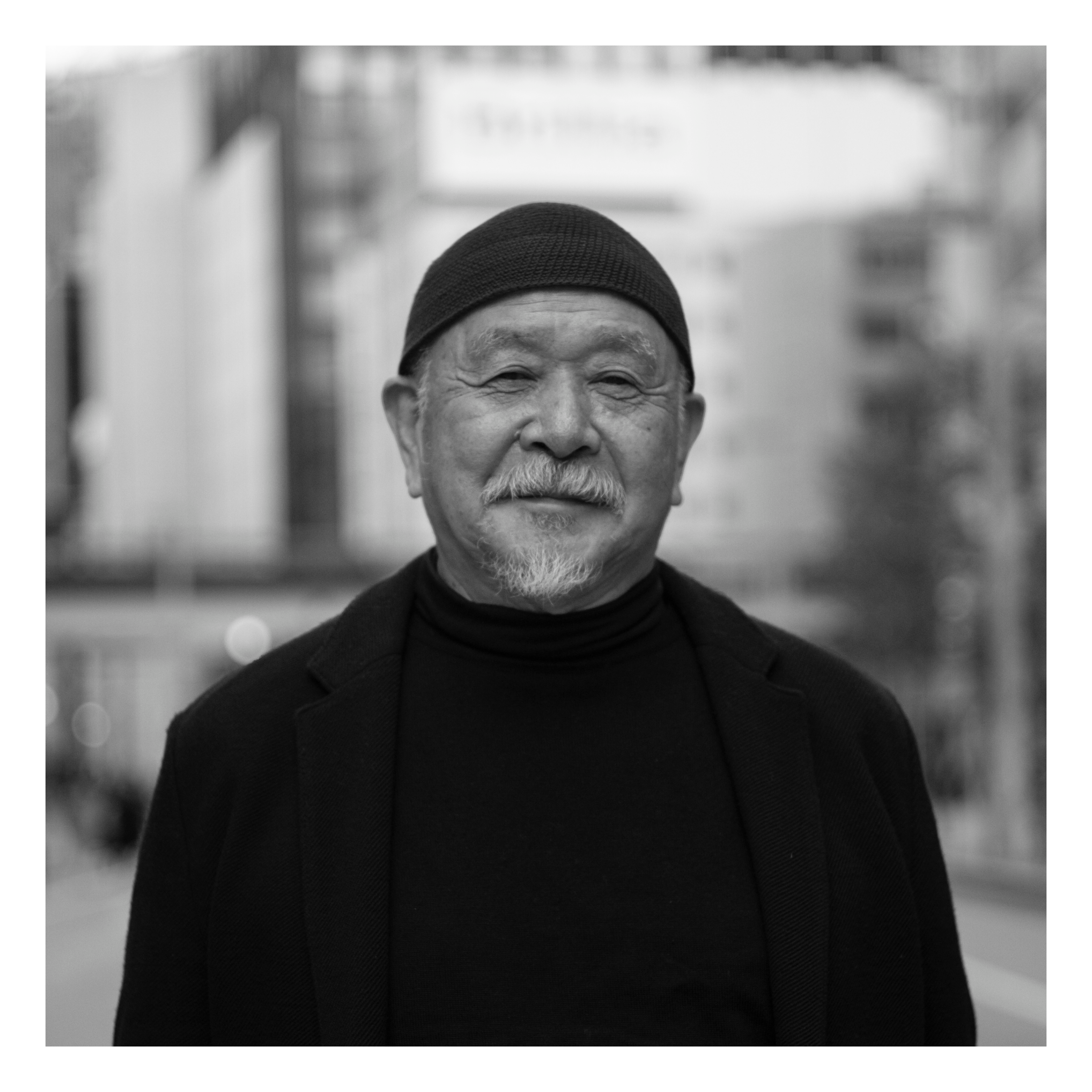
松原賢
Matsubara Ken
Biography
1948 Born in Kamiichi Town, Toyama Prefecture
1973 Independent Art (Tokyo Metropolitan Art Museum)
1976 Studied under Inoue Mitsutsuna
1977 Daiichi Art Exhibition Daiichi Art Award (Tokyo Metropolitan Art Museum)
1987: Won the Special Excellence Award at the Ueno Royal Museum Painting Grand Prize Exhibition (Ueno Royal Museum)
1990 "Exhibition of Artists Carrying on the Next Generation" (Hakone Open-Air Museum)
1991 "Art of Toyama '91" (Toyama Prefectural Museum of Modern Art)
2001 "Tochigi Prefectural Art of the 20th Century II: The Door of a Millennium" (Tochigi Prefectural Museum of Art)
2006 "Matsubara Ken Exhibition" (Espace Bertin Poiret Gallery/Paris, France, TKW20 Gallery/Cologne, Germany)
2008 "Matsubara Ken - The Transience of Life" (Organized by Toyama Museum of Modern Art/Toyama Prefecture)
2015 Solo Exhibition "Kei" (Ginza Ippodo)
2016 Solo Exhibition “A Solo Exhibition of Japanese Painter Ken Matsubara -Distillation-” (Ippodo New York)
2019 Solo Exhibition "Matsubara Ken -Sun, Moon, Sky, Sea" (Wako Hall)
Ippodo New York 67th Opening Event "KUKAI - Sun and Moon -"
The Philadelphia Museum of Art's sliding door painting "Sun, Moon, Sky, and Sea" is housed here.
2020 Solo Exhibition "Nichigetsukukai" (Ginza Ippodo)
2021 Solo Exhibition "Matsubara Ken Paints 'Wisteria'" (Ginza Ippodo)
2022 Solo Exhibition "Chaos to the Cosmos" (Ippodo Gallery New York)
"Chaos" folding screen, Minneapolis Institute of Art
In addition, he has held numerous solo and group exhibitions around the country.


